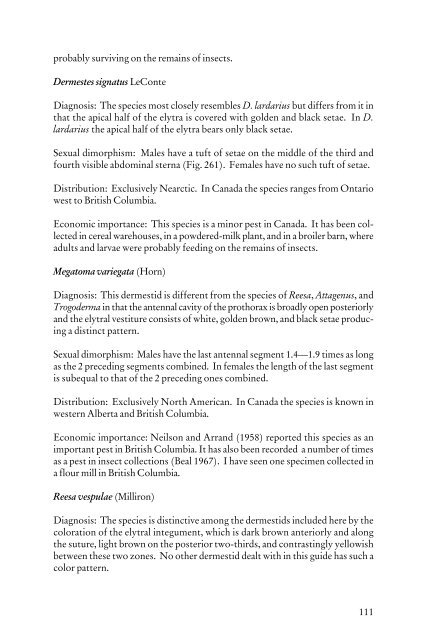Beetles Identification Guide
Beetles Identification Guide
Beetles Identification Guide
You also want an ePaper? Increase the reach of your titles
YUMPU automatically turns print PDFs into web optimized ePapers that Google loves.
probably surviving on the remains of insects.<br />
Dermestes signatus LeConte<br />
Diagnosis: The species most closely resembles D. lardarius but differs from it in<br />
that the apical half of the elytra is covered with golden and black setae. In D.<br />
lardarius the apical half of the elytra bears only black setae.<br />
Sexual dimorphism: Males have a tuft of setae on the middle of the third and<br />
fourth visible abdominal sterna (Fig. 261). Females have no such tuft of setae.<br />
Distribution: Exclusively Nearctic. In Canada the species ranges from Ontario<br />
west to British Columbia.<br />
Economic importance: This species is a minor pest in Canada. It has been collected<br />
in cereal warehouses, in a powdered-milk plant, and in a broiler barn, where<br />
adults and larvae were probably feeding on the remains of insects.<br />
Megatoma variegata (Horn)<br />
Diagnosis: This dermestid is different from the species of Reesa, Attagenus, and<br />
Trogoderma in that the antennal cavity of the prothorax is broadly open posteriorly<br />
and the elytral vestiture consists of white, golden brown, and black setae producing<br />
a distinct pattern.<br />
Sexual dimorphism: Males have the last antennal segment 1.4—1.9 times as long<br />
as the 2 preceding segments combined. In females the length of the last segment<br />
is subequal to that of the 2 preceding ones combined.<br />
Distribution: Exclusively North American. In Canada the species is known in<br />
western Alberta and British Columbia.<br />
Economic importance: Neilson and Arrand (1958) reported this species as an<br />
important pest in British Columbia. It has also been recorded a number of times<br />
as a pest in insect collections (Beal 1967). I have seen one specimen collected in<br />
a flour mill in British Columbia.<br />
Reesa vespulae (Milliron)<br />
Diagnosis: The species is distinctive among the dermestids included here by the<br />
coloration of the elytral integument, which is dark brown anteriorly and along<br />
the suture, light brown on the posterior two-thirds, and contrastingly yellowish<br />
between these two zones. No other dermestid dealt with in this guide has such a<br />
color pattern.<br />
111
















